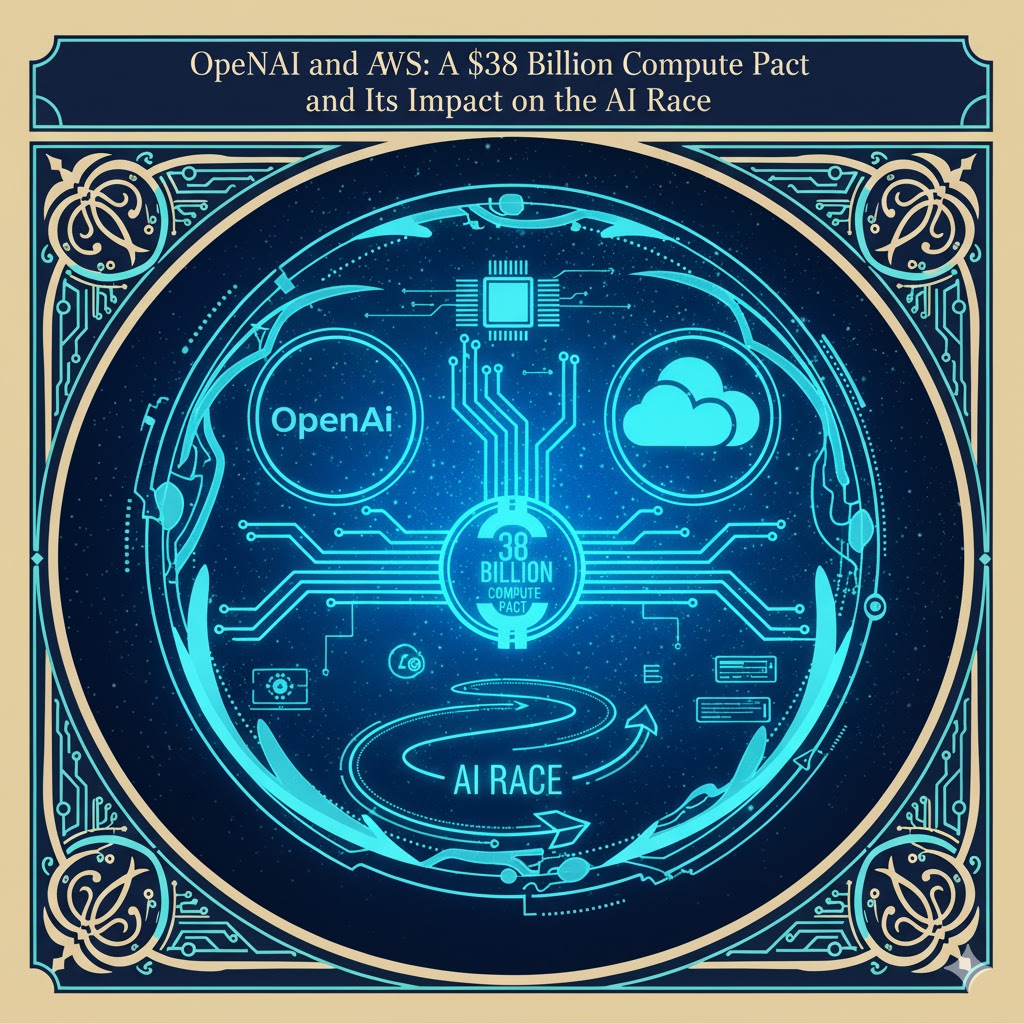Overview of the deal
On 3–4 November 2025, OpenAI and Amazon Web Services (AWS) announced a seven‑year strategic partnership in which OpenAI will purchase roughly US$38 billion worth of cloud services from AWS to power its frontier AI models. The agreement gives OpenAI immediate access to AWS’s infrastructure and commits the companies to bring hundreds of thousands of NVIDIA GPUs online for OpenAI by the end of 2026, with the ability to scale to tens of millions of CPUs and additional GPUs into 2027 and beyondreuters.com. This partnership is part of OpenAI’s broader plan to invest approximately US$1.4 trillion in computing resources over the next decadereuters.com.
The deal reflects OpenAI’s shift from an exclusive relationship with Microsoft Azure. After a restructuring in late October 2025, Microsoft waived its “first right of refusal” for supplying compute, enabling OpenAI to pursue a multi‑cloud strategylogisticsviewpoints.com. OpenAI still retains a separate US$250 billion commitment to Azure and smaller contracts with Oracle (US$300 billion) and Googlereuters.com, but the AWS partnership marks the company’s first large‑scale diversification of infrastructurelogisticsviewpoints.com.
What AWS provides
AWS will build new EC2 UltraServer clusters—liquid‑cooled clusters of NVIDIA GB200 and GB300 accelerators linked via high‑bandwidth interconnects—that are optimized for both training and inference. According to AWS and OpenAI, clustering the GPUs on the same network will enable low‑latency performance, allowing OpenAI to serve real‑time inference for ChatGPT and to train next‑generation modelsaboutamazon.com. The targeted deployment includes capacity of hundreds of thousands of chips and the possibility to expand to tens of millions of CPUsaboutamazon.com.
The agreement will roll out in phases: some capacity is already online, the majority is scheduled to be deployed by late 2026, and there is room for expansion through 2027+mexicobusiness.news. AWS CEO Matt Garman notes that AWS has experience operating clusters of more than 500,000 chips, a capability that helped secure the dealadwaitx.com.
Why OpenAI diversifies its cloud providers
OpenAI CEO Sam Altman has stated that “scaling frontier AI requires massive, reliable compute,” and that partnering with AWS will strengthen the broad compute ecosystem necessary to bring advanced AI to everyonelogisticsviewpoints.com. Several factors drove the shift:
- Compute scarcity and costs: Frontier AI models demand unprecedented computational power. OpenAI’s spending plan to build 30 GW of computing capacity—roughly the power output of 25 million U.S. homes—underscores the scale of its ambitionsreuters.com. By locking in capacity across multiple providers, OpenAI secures scarce GPU resources and can negotiate price competition between hyperscalersinvesting.com.
- Vendor lock‑in risk: After Microsoft’s exclusivity lapsed, OpenAI sought to reduce reliance on any single provider. The multi‑cloud strategy ensures flexibility to shift workloads across AWS, Azure, Google Cloud and Oracle, mitigating supply‑chain disruptions and price escalationslogisticsviewpoints.com.
- Financial and governance independence: The company’s October 2025 restructuring created a new for‑profit umbrella and removed Microsoft’s control rights. OpenAI can now raise funds more freely and pursue large partnerships such as the AWS dealreuters.com.
Impact on cloud competition
AWS gains legitimacy in the AI race
Before the partnership, investors worried that AWS was lagging in the AI infrastructure race. AWS’s share of the cloud market had declined from 34 % in 2022 to 29 % by September 2025reuters.com. Competitors such as Microsoft and Google had been winning large AI contracts, and Amazon lacked a flagship generative model like ChatGPTreuters.com. The OpenAI deal—though smaller than OpenAI’s Azure commitment—provides a marquee customer and signals that AWS can deliver frontier‑grade AI capacity. Analysts expect the deal could boost AWS’s backlog by about 20 % in Q4 2025, supporting Amazon’s record spending on AI infrastructurereuters.com. Amazon’s stock rallied about 5 % on the announcementreuters.com.
Intensified multi‑cloud competition
Microsoft still remains OpenAI’s largest partner, but its exclusive position is gone. Azure continues to invest heavily—OpenAI agreed to spend US$250 billion more on Azure capacity, and Microsoft simultaneously invests in its own AI data centersreuters.com. Oracle provides specialized compute under a US$300 billion deal and has also partnered with SoftBank on the Stargate data‑center project. Google has smaller agreements with OpenAI and invests heavily through its partnership with Anthropicreuters.com.
The AWS partnership thus marks the normalization of multi‑cloud AI ecosystems. Logistics Viewpoints notes that this shift is analogous to diversified supply chains: it reduces vendor lock‑in, encourages cross‑vendor interoperability and compels infrastructure providers to adopt open standardslogisticsviewpoints.com. Matt Garman highlighted that AWS brings scale and maturity to AI infrastructure, positioning itself as a co‑equal pillar in OpenAI’s compute strategylogisticsviewpoints.com.
Pressure on GPU supply chains and cost structures
Hyperscalers are racing to secure GPUs from NVIDIA and other chipmakers, turning compute capacity into a global commodity. Logistics Viewpoints likens the long‑term compute contracts to traditional manufacturing procurement: securing scarce resources ahead of demandlogisticsviewpoints.com. Analysts caution that the scale of commitments—more than US$1 trillion across OpenAI’s deals—creates a capital‑intensive arms race. A Medium analysis describes this as an “infrastructure‑revenue paradox,” noting that OpenAI currently spends more than it earns and must innovate monetization models to sustain these investmentsalecfurrier.medium.com.
For competitors, the arms race means that access to chips—and the ability to finance them—will be the primary differentiator. Companies without trillion‑dollar war chests may struggle to compete unless they form consortia or specialize in niche verticals.
Implications for customers in key verticals
1. Digital commerce and retail
Digital Commerce 360 notes that beyond infrastructure headlines, the OpenAI‑AWS pact signals a fundamental shift for online retaildigitalcommerce360.com. With vast compute capacity, OpenAI can develop faster, more context‑aware models that power agentic commerce—AI assistants that autonomously research, recommend and transact on behalf of shoppersdigitalcommerce360.com. Consumers could ask natural‑language queries like “find me the best power drill under $200 with same‑day delivery,” and AI agents will handle search, comparison and orderingdigitalcommerce360.com. For merchants, the ability to serve billions of personalized recommendations simultaneously can increase conversion and reduce frictiondigitalcommerce360.com.
In B2B commerce, large‑scale models can automate procurement, inventory and pricing decisions, forecast demand across distributor networks, and dynamically adjust bulk‑order pricingdigitalcommerce360.com. The compute backbone ensures low‑latency interactions between agent‑based systems, paving the way for autonomous negotiation between buyers’ and sellers’ AI agentsdigitalcommerce360.com. Digital Commerce 360 argues that computing capacity has become the new logistics: just as physical distribution centers determine delivery speed, compute clusters will determine the intelligence of shopping experiencesdigitalcommerce360.com.
2. Supply chain and industrial technology
Logistics Viewpoints interprets the partnership as a structural shift toward multi‑cloud AI for industrial sectors. It highlights several implications:
- AI infrastructure becomes a supply chain of its own—GPUs and networking fabric are constrained commodities, leading enterprises to lock in capacity through long‑term contractslogisticsviewpoints.com.
- Multi‑cloud neutrality reduces vendor lock‑in—mirroring diversified sourcing strategies in physical supply chainslogisticsviewpoints.com.
- Cross‑vendor interoperability matters—operational AI at scale will require standard APIs and data‑plane orchestration across providerslogisticsviewpoints.com.
- Capital‑expenditure discipline—CFOs and CIOs must evaluate utilization and ROI as multi‑year AI compute deals exceed US$1.4 trillionlogisticsviewpoints.com.
For supply‑chain and manufacturing customers, access to frontier AI could enable digital twins, advanced simulations, and optimization engines for route planning, demand forecasting and warehouse automationlogisticsviewpoints.com. The AWS deployment can deliver lower latency and new pay‑as‑you‑go models designed for AI‑intensive industrial applicationslogisticsviewpoints.com.
3. Media, research and developer ecosystems
By diversifying to AWS, OpenAI ensures more reliable uptime and faster response times for ChatGPT and API users. AWS’s global network and low‑latency architecture can reduce inference bottlenecks, improving user experience for applications such as coding assistance, content generation and scientific analysisaboutamazon.com. Amazon’s blog notes that thousands of customers—including Peloton, Thomson Reuters, Comscore and Triomics—are already using OpenAI models via Amazon Bedrock, and the expanded partnership will bring those customers enhanced performance and scalabilityaboutamazon.com.
For startups and independent developers, the multi‑cloud environment may lead to price competition between Azure, AWS, Oracle and Google. A piece on Investing.com observes that diversifying cloud servers could introduce pricing competition among providers and that AWS’s ability to expand to tens of millions of CPUs will rapidly scale agentic workloadsinvesting.com. This could translate into more favorable pricing for API credits and compute time, though the capital costs will eventually be reflected in usage fees.
4. Competing AI platforms
The partnership also affects other AI developers and platforms. AWS is already a primary cloud provider for Anthropic, a competitor to OpenAI, and is investing US$11 billion to build a data‑center campus dedicated to Anthropic’s workloadsmexicobusiness.news. By securing OpenAI’s workloads as well, AWS strengthens its position as an arms supplier to multiple AI labs. This dual role may benefit customers through cross‑pollination of innovations but could also create conflicts if resources are prioritized.
Conversely, Google and Microsoft will likely accelerate their own AI offerings—Microsoft’s MAI‑Image‑1 (an in‑house image generator) and Google’s Gemini models—while courting third‑party developers with integrated solutions. The arms race may spur open‑source alternatives as well, as smaller players seek less expensive paths to innovation.
5. Financial and environmental considerations
OpenAI’s multi‑cloud commitments highlight the unsustainable economics of AI. The company reportedly spends US$2.25 for every dollar earned and plans to deploy US$1.4 trillion in computing infrastructurealecfurrier.medium.com. Analysts warn that the infrastructure‑to‑revenue ratio (about 6:1) exceeds that of the dot‑com and railroad boomsalecfurrier.medium.com. If revenue growth fails to keep pace, customers may face higher costs or reduced investment in model improvements.
There are also energy implications. Operating tens of millions of CPUs and hundreds of thousands of GPUs will demand significant power—equivalent to powering millions of homes. Enterprises and regulators will scrutinize the sustainability of these data centers, and some may push for renewable energy sources or demand‑response schemes.
Conclusion
The OpenAI–AWS US$38 billion partnership marks a pivotal moment in the AI infrastructure race. It ends Microsoft’s exclusivity, legitimizes AWS as a top-tier AI cloud, and inaugurates a multi‑cloud era where compute capacity becomes a strategic resource. For competition, the deal intensifies the arms race among hyperscalers and chip suppliers while forcing cloud providers to innovate and open their ecosystems. For customers, the partnership promises faster, more capable AI services that will reshape digital commerce, supply chains, developer tools and other verticals. However, the capital intensity of these commitments means users must weigh the benefits of frontier AI against potentially higher costs and environmental impacts. As compute becomes the new logistics and energy becomes the new currency, the winners will be those who can harness massive AI models while maintaining financial and operational sustainability.









